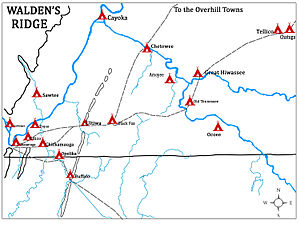- Chickamauga Indian
-
The Chickamauga or Lower Cherokee, were a band of Cherokee who supported Great Britain at the outbreak of the American Revolutionary War. They were followers of the Cherokee chief Dragging Canoe. In the winter of 1776/1777, he and they moved down the Tennessee River away from the historic Overhill Cherokee towns, establishing almost a dozen new "towns", isolated from colonists' encroachment. The frontier people often referred to them as "Chickamaugas" after the name of the new town on the Chickamauga River where Dragging Canoe resided.
After the Cherokee moved further west and southwest five years later, they were more commonly known as the "Lower Cherokee," after the "Five Lower Towns" originally making up the new settlement. They never considered themselves distinct from the Cherokee people. Richard Fields, a minor leader of the so-called "Chickamauga", was asked by a Moravian missionary Brother Steiner, "What kind of people are the Chickamauga?"; in reply, Fields laughed and said, "They are Cherokee, and we know no difference." [1]
Contents
"Establishment" of the Chickamauga
"Chickamauga" towns
Establishing these communities further down river allowed (at least initially) the band to insulate themselves from the constant encroachment of settlers migrating west from Georgia, Tennessee, Virginia and North Carolina. Migration increased in the years following the Revolutionary War. Dragging Canoe and his Lower Cherokee settled at the place where the Great Indian Warpath crossed the South Chickamauga Creek, near present-day Chattanooga, Tennessee. In 1782, the eleven Cherokee towns were destroyed by militia forces under John Sevier and William Campbell. Dragging Canoe led his people further down the Tennessee River.
"Five Lower Towns"
Dragging Canoe relocated his people west and southwest, into new settlements centered on Running Water (now Whiteside) on Running Water Creek. The other towns founded at this time were: Nickajack (near the cave of the same name), Long Island (on the Tennessee River), Crow Town (at the mouth of Crow Creek), and Lookout Mountain Town (at the site of the current Trenton, Georgia).
Constant war
Main article: Chickamauga Wars (1776-1794)The Chickamauga became known for their uncompromising enmity against United States settlers, who had pushed them out of their traditional territory. From Running Water, Dragging Canoe led attacks on white settlements all over the American Southeast. Later, his Chickamauga warriors raided as far as Indiana, Kentucky and Virginia (along with the Western Confederacy —which they helped establish). Due to a growing belief in the Chickamauga cause, as well as the destruction of the homes of the other Native Americans, a majority of the Cherokee came to be allied against the US.
After the death of Dragging Canoe in 1792, his hand-picked successor John Watts assumed control of the Chickamauga. Under Watts' lead, the Chickamauga continued their policy of Indian unity and hostility toward European Americans. Watts moved his base of operations to Willstown to be closer to his Muscogee allies. Prior to this, he had concluded a treaty in Pensacola with the Spanish governor of West Florida, Arturo O'Neill, for arms and supplies with which to carry on the war. The Chickamauga and the frontiersman were continuously at war until 1794, in what were called the Chickamauga Wars.
Classification of the Chickamauga
In 1799 Brother Steiner, a representative of the missionary Moravian Brethren, met at Tellico Blockhouse with Richard Fields, a former Lower Cherokee warrior whom he had hired to serve as guide and interpreter. Steiner had been sent south to scout for a location for a mission and school they planned to build, which was ultimately located at Spring Place (Georgia) on land donated by James Vann. Steiner asked his guide, "What kind of people are the Chickamauga?". Fields laughed, then replied, "They are Cherokee, and we know no difference."[1]
The Chickamauga Towns and the later Lower Towns were groupings for geographic description, as with the Overhill, Valley or other geographically described Cherokee. At the time, the Cherokee were organized by clan (with a matrilineal system of property and descent) and town. Each of the clans had different functions within the towns and tribe. They had regional councils, but these did not have binding political power.
The only "national" position which existed before 1788 was that of First Beloved Man, who was a chief negotiator selected from the Cherokee towns farthest from the reach of intruders. After 1788, the Cherokee established a National Council, but at first it met irregularly and had no prescriptive or proscriptive powers. After the peace of 1794, the Cherokee were organized into five groups: the Upper Towns (formerly the Lower Towns of western Carolina and northeastern Georgia moved to North Georgia), the Overhill Towns, the Hill Towns, the Valley Towns, and the (new) Lower Towns. Each group had regional councils which were considered more important than the "national" council at Ustanali.
Dragging Canoe often spoke to the National Council at Ustanali; and he publicly acknowledged Little Turkey as the senior leader of all the Cherokee. Dragging Canoe was memorialized at the council following his death in 1792. There was constant communication between leaders of the "Chickamauga" and the Cherokee of other regions, they fought together in certain actions, and the "Chickamauga" chiefs signed treaties with the federal government, along with other leaders of the Cherokee, as Cherokee.
Modern descendants of Chickamauga
Several groups of persons claim to be descended from the Chickamauga and have named their groups after them. They are generally found among the unrecognized bands.
References
Categories:- Chickamauga Indian
- Cherokee people
- Native American culture
- Slavery in the United States
- History of the Cherokee
- Pre-state history of North Carolina
- Pre-state history of Tennessee
- State of Franklin
Wikimedia Foundation. 2010.


